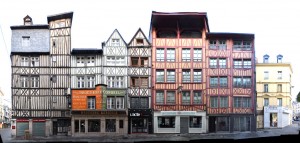Rouen [latin: Rotomagus], was founded by the tribe of the Veliocasses as Ratumacos, lies about 100 km north-west of Paris and 200 km south of London on the shores of the river Seine. 2nd largest city in the Normandy and 33rd largest city in France.
Population: 111.000 [2013] | 103.000 [1990] | 123.000 [1931] | 116.000 [1901]
The roman Rotomagus was the second most important city of the roman province Gallia after Lugdunum (Lyon). It has been the seat of a bishop since the 4th century. Rouen was captured by the Normans in the 9th century and became the first capital of the Duchy of Normandy in the early 10th century. After the French conquered it again in 1204 it once again belonged to the brittish crown from 1419 to 1449. In late medieval times Rouen was one of the largest european cities with about 40.000 inhabitants. It was here that Joan of Arc was burned at the stake in 1431. Today the city is known for its gothic cathedral and for having the largest number of preserved timber framed buildings in France.
The Rue du Gros-Horloge is a grand example for half-timbered buildings in Rouen. Indeed it is the major street between the cathedral square, we see the Rouen Cathedral at the left edge, and the old marketsquare – the Place de Vieux Marché. The street is named after Rouen’s second landmark, the Gros-Horloge, situated a little further down the right side of the street. It is a fourteenth-century astronomical clock, prominently placed at the side of a tower crossing the street and facing the cathedral.
Find more material from the Normandy in our Normandy overview.
Click for larger view:
For classic view and more infos about the street:
We documented several more streets in Rouen, including more stretches of the Rue du Gros-Horloge, for example (unfinnished):
And a section following the main panorama further down the right ending at the Gros-Horloge (unfinnished):
Here is an unfinnished preview of a little side street, Rue Ecuyere:
Previously published from Rouen: Rue Ganterie









